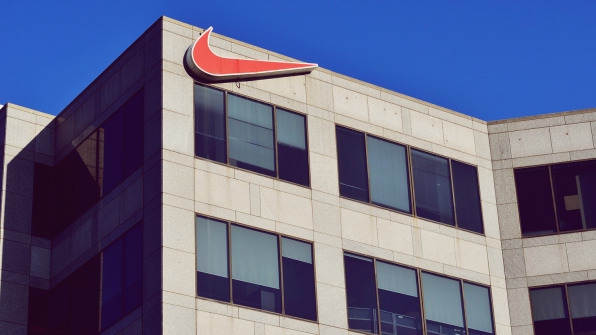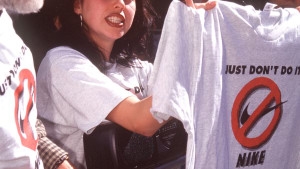Escalating Sweatshop Protests Keep Nike Sweating
(This story has been updated to reflect a new statement from Nike about its stance on sweatshops.)
College students protesting outside Nike stores around the country. Workers recently laid off at a factory in Honduras holding a rally to condemn the sportswear giant’s treatment of employees. Activists in a group called United Students Against Sweatshops (USAS) organizing a “Global Call to Action Against Nike” to draw attention to allegations of mass fainting, wage theft, and padlocked exits at factories.
It may seem like a flashback to the 1990s, when Nike became the poster child for corporate irresponsibility and was regularly targeted by anti-sweatshop activists. Over the next decade and a half, the company made serious efforts to reform its practices, adopting one of the business world’s first codes of conduct and winning praise from labor activists. But in recent months Nike has lost much of that goodwill, amid similar allegations, and is sparking new protests led by a new generation of activists.
Benjamin Simonds-Malamud, a sophomore at Northeastern University, recently took an interest in workers’ rights. Several weeks ago, he joined a conference call hosted by USAS in which union leaders at the Honduras Star factory discussed what had happened to workers when Nike abruptly ended its contract.
“We heard about how this had devastated the local economy there and how those workers were fighting for production–and their livelihoods–to come back,” Simonds-Malamud says. “Hearing about that firsthand had a big impact on me. I’m down to support any campaign that will improve people’s lives and show solidarity with people who are being exploited.”
On Saturday, he will be among the students standing in front of Niketown, a large Nike store on Newbury Street, Boston’s posh shopping district. He anticipates about 30 others will join him. Small rallies like this are planned in front of Nike retail stores around the country. In the past, even small USAS-organized rallies have prompted certain stores to shut down for a few hours, forcing Nike to lose revenue.
When reached for comment, a Nike spokesperson clarified that it was not Nike’s decision to leave the Honduras factory. Instead, it was kicked out by Gildan Inc., a large apparel company that recently acquired American Apparel, when it took over the facility. “Nike, along with the other brands in the factory, were informed that Gildan would take over 100% of factory production, replacing current brands with their own apparel brands,” Nike’s spokesperson said. “We have been advocating that Gildan work to minimize the impact on their workers.”
Angeles Solis, a national organizer for USAS, makes it clear that Nike is just one of many corporations that she claims violate workers rights around the world. Her organization has also gone after Adidas, REI, North Face, and many other corporations. But since Nike is the biggest sportswear brand on the market, it is important to shed light on what it is doing and try to change it. “Nike has been a target in the past because it does have a history of sweatshop violations,” says Solis. “Nike is not going to go away: It is the biggest sports apparel manufacturer in the world. So our goal is to improve worker conditions and practices.”
But the Honduras factory layoffs are just part of a broader pattern of activity on Nike’s part that has outraged these students. Two years ago, Nike stopped allowing independent inspectors to monitor working conditions at Nike factories, saying that it would instead carry out these checks on its own. Since then, there have been reports of terrible working conditions inside these factories.
In Cambodia, for instance, 500 workers inside a plant that supplies products to Nike, Puma, Asics, and the VF Corporation were hospitalized after fainting out of exhaustion and hunger as a result of working 10-hour shifts, six days a week, in 98-degree heat.
Defying Nike’s policy that bars the entry of investigators into their factories, watchdog group Worker Rights Consortium managed to get access to a plant in Hansae, Vietnam. It was able to document a string of alleged abuses there including wage theft, forced overtime, restrictions on the workers’ use of toilets, exposure to toxic solvents, and padlocked exit doors. “Workers (were) collapsing unconscious at their sewing machines due to heat and overwork,” the report said.
Nike has been a target of anti-sweatshop protests since 1991, when an activist produced a report about factory conditions in Indonesia. However, over the years, it has attempted to improve its image by increasing monitoring in factories and working with human rights groups to clean up its supply chain. In 2005, it became the first in the sportswear industry to be fully transparent about all the factories with which it partners, publicly posting its audits. However, its policy of preventing third-party investigators from verifying its claims has reignited the debate about working conditions at Nike’s supplier factories.
Nike has clarified that it continues to allow third-party audits at all of its factories. However, it has chosen not to cooperate with the Worker Rights Consortium because the organization was founded by USAS. “We respect the Worker Rights Consortium’s (WRC) commitment to workers’ rights while recognizing that the WRC was co-created by United Students Against Sweatshops, a campaigning organization that does not represent the multi-stakeholder approach that we believe provides valuable, long-lasting change,” Nike’s spokesperson says.

College students have been vital in helping to change how big corporations like Nike manage their supply chains, especially since 1997 when they first began such large-scale protests. And the company has attracted particular attention on campuses, since Nike has lucrative deals with universities to supply gear for their athletic teams. Over the last two decades, worker’s rights organizations like the Worker’s Rights Consortium have had a strategy of educating students about Nike’s alleged overseas violations. Student activists, for their part, can apply pressure to university administrators to end contracts with Nike until it can prove it is treating workers properly.
“The collegiate market for Nike is huge,” says Solis. “It produces athletic gear and bookstore apparel, and sponsors games. The University of Texas, Austin, for instance, has a $250 million contract with Nike.”
This approach of targeting colleges has proven particularly effective. The athletics programs of the University of California Berkeley and Los Angeles had been sponsored by Nike, but in August the schools switched their sponsorship to Under Armour in a 10-year agreement. Georgetown, the University of Washington, and Northeastern cut their ties with Nike until it allows the Worker’s Rights Consortium access to its factories. Rutgers has allowed its relationship with Nike to expire and has asked any company that bids on its athletic sponsorship to allow periodic inspections of supplier factories.
In the past, Nike has responded to these student protests with targeted measures. In 2010, for instance, it paid $1.54 million to help 1,800 workers in Honduras who lost their jobs when Nike closed a factory there—this came after USAS pressured the company to offer severance pay that had been denied to workers by the factory.
“This is not the first time we’ve fought Nike,” Solis says. “And in the past, we’ve beat them.”
Nike worked hard to improve conditions in its factories around the world, but activists say the company has been slipping back into using sweatshops.
(This story has been updated to reflect a new statement from Nike about its stance on sweatshops.)
Fast Company , Read Full Story
(42)













